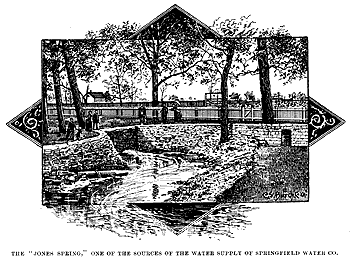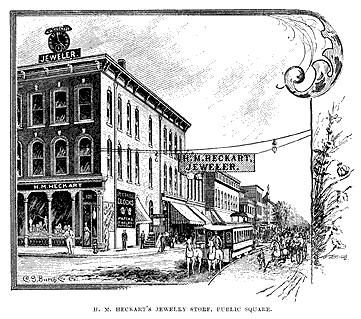SPRINGFIELD, MISSOURI AND SURROUNDINGS • 1889
(previous page) more local capitalists, his theory being that this city is clearly within the gas belt of the States and districts above named. There is NO FINER WATER SUPPLY in America, than that of Southwest Missouri and the outlying districts within the region above outlined. Thousands of clear, cold rock springs breaking into brooks and creeks, pour their bright waters into the Osage, Gasconade, Black, White, Current Spring, James and other rivers, from all sides of this Ozark range, giving the country a supply of pure, hard and soft water, unequaled elsewhere in the West. Many of these springs are of great volume, forming large streams and SPLENDID WATER POWER at their very sources, and it is safe to say that the reliable unutilized water now going to waste within a radius of 135 miles of Springfield, would furnish motive power to drive all the machinery of the Eastern States. Within this same radius too, are agricultural resources greater than in all the six New England States. THE SOILS are unexcelled, both in variety and essential value. The prairie soils which cover about 80 per cent. of the region outlined, are composed of the same rich, black, flexible loams as the prairie soils of Illinois. They are from twelve to twenty inches deep, abound in humus and produce fine crops of everything grown in the latitude. THE OAK AND HICKORY SOILS, which cover full 45 per cent. of the whole country, are identical with the mulatto red and chocolate colored woodland soils of Kentucky, Virginia, Maryland and Eastern Pennsylvania, and are among the most enduring, versatile and valuable soils in the country. They are abundant in silica, lime and magnesia carbonate, lime phosphate and organic matter, improve with age and cultivation and are clearly the finest wheat, clover, fruit and tobacco lands in the country. Below them are enormously rich deposits of SILICIOUS CLAYS AND MARLS, nearly identical with the bluff or loess formation of the Missouri Valley and the famous lacustrine deposits of the Rhine and Nile. These sub-soils are PRACTICALLY IMPERISHABLE, and form the finest basis for fruits, grains, vegetables and grasses, known to the world. Ages of cultivation cannot exhaust them, for they are rich in the finest phosphate, carbonates and silicious and organic matter and run down to the bed rock or water-level. THE VALLEY AND BOTTOM LANDS are richer, warmer, quicker and more productive than even the famous lowlands of the Eastern States, for they not only carry the alluvial deposits of centuries, but hold in grand measure the richest sediment from the disintegrated lime formations of the tributary hills. They are the most productive soils in the world, and for wheat, corn, cotton, vegetables, fruits—everything—are unrivaled. Including the slopes, the valley lands cover about 10 per cent. of this great region. Not more than 15 per cent. of the whole country may be called mountainous, or too rough, rocky and sterile for cultivation. About 10 per cent. of the oak and hickory lands are too abundant in float lime-rock to admit of easy or profitable cultivation. Out these limited areas are among the finest orchard and vinelands in the country, and are in unwise a blemish upon this fair and fruitful region. The bluff or mountainous districts, too, are far from useless, for they furnish the great springs of which hundreds of clear streams are born, and the motor that is some day to drive hundreds of mills and factories and wake the echoes of the woods and hills with the glad music of industry. They abound in valuable commercial timber, too, and furnish a good measure of the wild grazing herbage of the country. It is safe to say that not more than 18 or 20 per cent. of the radius herein outlined is under tribute to the plow; and yet its AGRICULTURAL POSSIBILITIES are as incalculable as they are unrivaled. The soils are not only generous, responding quickly and bountifully to the call of the husbandman, but they are certainly among THE MOST VERSATILE or variously gifted soils, in point of production, that are known to modern husbandry. Within these 25,000 square miles of territory they grow in perfection everything that flourishes between the cotton and sugar fields of the South, and the wheat fields of Manitoba. Climate and soils alike favor the widest range of production (next page)
Page
1 | 2 | 3 | 4 | 6 | 7 | 8 | 9 | 10 | 11 | 12 | 13 | 14 | 15 | 16 | 17 |
18 | 19 | 20 | 21 | 22 | 23 | 24 | 25 | 26 | 27 | 28 | 29 | 30 | 31 | 32 | 33 | 34 | 35
Springfield 1889 Home | Keyword Search | Engravings Thumbnails | Local History Home


